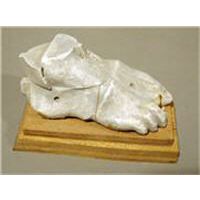Online Collections at UoB - Objects
ID number: BIRRC-A0975o
Institution: Research and Cultural Collections
Named collection: Campus Collection of Fine and Decorative Art
Artist / Maker: Paolozzi, Eduardo (1924-2005)
Title / Object name: Medium Romanesque Foot (broken)
Object type: Sculpture
Materials: Plaster
|

|
This collection of plaster maquettes was bequeathed to the University of Birmingham by the artist Sir Eduardo Paolozzi R.A. on his death in 2005. Paolozzi’s art mirrored a wide range of ideas, resulting in a broad array of subject matter explored through unconventional and imaginative sculptural forms. This collection represents a fragment of Paolozzi's sculptural output, with subjects as disparate as a pair of crickets mating, a car engine, a turreted castle and a single human ear. Paolozzi used both nature and geometric shapes in his treatment of the human figure. As we can see here, he did not attempt to capture the likeness of an individual, but combined fragments of automotive and computer parts to suggest primitivistic robots. This fusing of organic and mechanical elements can be seen in Paolozzi’s imposing bronze sculpture Faraday at the West Gate. This was a gift to the University from the artist in 2000. Although principally a sculptor, Paolozzi was also a pioneering printmaker. His seminal collage I was a Rich Man's Plaything (1947) is one of the earliest standard bearers of Pop Art. Some fine examples of his collage-based silkscreen images can be found around campus. Paolozzi’s print series Calcium Light Night and Moonstrips Empire News are displayed in the Music Department of the Arts building and in the entrance to the Law department respectively. Z.E.E.P. is on the ground floor of the Arts Building, and B.U.N.K. is installed in American Studies. Some of the maquettes are experiments that were never realised, whilst others were used as models for much larger works in bronze. To turn these maquettes into bronze sculptures Paolozzi used the lost-wax method. A rubber mould is first made around the plaster, and then filled with molten wax, to leave a perfect wax version of the maquette. The wax is then surrounded with plaster to make a further mould, and melted out by molten bronze which replaces it: this is an ancient process. The seated figure in the centre of this display was cast in such a way, and enlarged to create the 5 metre tall self-portrait in bronze named The Artist as Hephaestus.
|
| << Viewing Record 769 of 1323 >> |